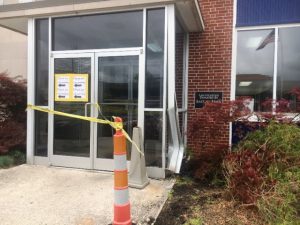News
Man Charged with Trespassing on Neighbors’ Property
April 23, 2018
By: Dwayne Page
A man has been charged with aggravated criminal trespassing after allegedly entering the home of his neighbors without permission.
38 year old Brian Edward Clark of Patterson Road, Smithville is under a $5,000 bond and his court date is May 2. Sheriff Patrick Ray said that on Sunday, April 22 a deputy was dispatched to a residence on Patterson Road due to a suspicious person. Upon arrival he spoke with two women who reported that their neighbor, Clark entered their residence without permission. Clark was found at another home on Patterson Road and placed under arrest.
23 year old Taylor Nicole Hensley of Floyd Drive, Smithville was cited for simple possession of a schedule II controlled substance after detectives conducted a probation search of her at a residence on Lee Homer Road, Smithville Friday, April 13 and found 0.01 gram of a substance believed to be methamphetamine. Her court date is April 26.
20 year old Hadley Anne Tucker of South Rutherford Boulevard, Murfreesboro is charged with no drivers license and cited for expired registration, no insurance, and violation of the light law. Her bond is $3,000 and her court date is May 3. Sheriff Ray said that on Tuesday, April 17 while traveling on Highway 70 a deputy spotted a vehicle with a light not working and conducted a traffic stop. He spoke to the driver, Tucker who produced an identification only issued by the state. Tucker said she did not have a driver license and that she had been in trouble before for the same offense. A computer check verified that she had no license. Her registration expired on May 30, 2017.
33 year old Jennifer Nicole Harvey of Nashville Highway, Dowelltown is charged with domestic assault. Her bond is $2,500 and she will be in court on May 3. Sheriff Ray said that on Tuesday, April 17 a deputy was dispatched to a residence and upon arrival spoke to a man who said his wife, Harvey had grabbed his cell phone from his hand while he was trying to record her yelling at him. As he tried to get the phone back from her, she threw it across the room causing physical contact between them which he found extremely offensive and provocative.
46 year old Vickie Lenae Alvis of High Street, Alexandria is charged with a 3rd offense of driving under the influence and a 4th offense of driving on a revoked license. Alvis’ bond is $10,000 and her court date is May 3. Sheriff Ray said that on Wednesday, April 18 a detective was traveling east on Highway 70 when he spotted a vehicle in front of him cross over several times into the opposite lane of travel. The officer conducted a traffic stop and spoke with the driver, Alvis. He smelled the odor of alcohol on her person and noticed an open beer in the vehicle. Alvis performed poorly on field sobriety tasks. She also submitted to a blood test. Her prior DUI offenses were in 2011 and 2013. A computer check revealed that her license were revoked for a DUI in 2013 and that she had prior driving on revoked charges against her in 2013, 2014, and 2015.
39 year old Amy Renee Ford of Chumbley Hollow Road, Watertown is charged with assault. Ford’s bond is $3,000 and her court date is May 10. Sheriff Ray said that on Friday, April 20 a correctional officer heard shouting coming from the cell where the females are housed at the jail and went to investigate. The officer witnessed Ford hitting another female inmate in the face several times with an open hand. Ford was determined to have been the primary aggressor and was arrested for assault.
Public meeting set for Center Hill Dam Modification Study
April 23, 2018
By: Dwayne Page
The U.S. Army Corps of Engineers Nashville District is hosting a public scoping meeting 6-8 p.m. Thursday, May 3, 2018 at the Buffalo Valley Community Center to present information to the public regarding a current Dam Safety Modification Study (DSMS) to further reduce risk at Center Hill Dam. The center is located at 2717 Buffalo Valley School Road, Buffalo Valley, Tenn.
Since 2008 the Nashville District has worked to reduce risk at Center Hill Dam from a foundation seepage issue.
“More recently, however, operability issues have been identified with the 70-year old main dam spillway gates that add project risk during a large flood event” said Corps Project Manager, Linda Adcock.
In the early 1990’s a self-eroding structure called a ‘fuse plug’ was built into the top of the saddle dam to add the ability to safely pass a rare, extreme flood downstream.
“If the main dam spillway gates don’t operate as intended, the fuse plug on the saddle dam could operate at a smaller flood than intended,” Adcock added.
Currently, risk of this occurrence is higher than the Corps deems acceptable. A study is underway to evaluate spillway gate repair alternatives and potential changes to standard gate operations during a large flood. Pursuant to the National Environmental Policy Act (NEPA) of 1969, as amended, the Corps of Engineers is initiating scoping and preparing a draft Environmental Impact Statement (EIS) to support the DSMS. The study will produce a recommended plan to reduce potential project risk. The Corps seeks public input on the array of alternatives being considered.
Examples of measures, either individually or in combination, that have potential to affect structures or operations of the dam may include:
a) Replacement of the current gate machinery with hydraulic machinery that can operate under water;
b) Addition of equipment to the current spillway gates to keep them open if the operating machinery is underwater;
c) Modification of the spillway gates or gate machinery to allow operation from the top of the dam;
d) Relocation of the gate operating machinery to the road level, which would require raising or relocating Highway 96 that crosses over the dam;
e) Modification of the emergency operations plan in the water control manual that determines how to manage floods at Center Hill Dam; and
f) Other measures as identified by on-going engineering studies, the public, and agencies.
The announcement seeking public input is located on the Federal Register at https://www.federalregister.gov/documents/2018/04/20/2018-08291/intent-t…. This announcement includes information on how to provide comments to the Corps of Engineers regarding this study.
To read more on the dam safety project, visit the Nashville District webpage at http://www.lrn.usace.army.mil/Missions/Current-Projects/Construction/Cen… . For more information about the U.S. Army Corps of Engineers Nashville District, visit the district’s website at www.lrn.usace.army.mil, on Facebook at http://www.facebook.com/nashvillecorps and http://www.facebook.com/centerhilllake , and on Twitter at http://www.twitter.com/nashvillecorps.
Car Hits Entrance to Post Office Building
April 23, 2018
By: Dwayne Page
An accident at the Smithville Post Office Monday morning caused some damage to the front entrance but no one was injured.
According to Smithville Police, 77 year old Marilynn Shea was pulling up to park at the post office in a 2008 Hyundai Accent and attempted to apply the brake when she accidentally stepped on the accelerator pedal causing the car to hit the front of the post office building.
Shea was not hurt.
After the accident, a sign was posted on the front door directing patrons to a side entrance to the building.
« First ‹ Previous 1 2358 2448 2456 2457 24582459 2460 2468 2558 2569 Next › Last »













